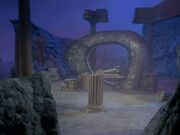- See also: History
Interstellar history was the term for the timeline of events and was a course at Starfleet Academy. (VOY: "Year of Hell")
The distant past[]
- Main article: Distant past
Billions of years ago[]
16 billion years ago

The creation of the universe
The universe comes into being through a massive explosion known as the Big Bang, gradually condensing into the more standard forms of matter and energy known in present time. At least two members of the Q Continuum, visiting from the future, are known to have taken refuge at the beginning of the cosmos, with one, later known as Quinn, also attempting to conceal the USS Voyager in the maelstrom. (VOY: "Death Wish")
The age of the universe was given in VOY: "Good Shepherd" as 16 billion years, which was the estimated age during the filming of the episode. Current real-world scientific evidence indicates the age of the universe to be 13.799 ± 0.021 billion years.
~ +5 billion years ago

The Guardian of Forever
The Guardian of Forever, a sentient time portal of unknown origin and purpose, is created on what will later be known as the time planet at some point preceding the formation of the Sol solar system. (TOS: "The City on the Edge of Forever")
~ 4 billion years ago

Ancient humanoid life
The first humanoid species known to evolve explored the cosmos, but found themselves alone. Accepting the lifespan of their own race to be ultimately finite, they chose to spread genetic material throughout the oceans of many worlds of the galaxy, including Andor, Bajor, Betazed, Cardassia Prime, Earth, Indri VIII, Ruah IV, Qo'noS, Tellar, Trill, Vilmor II, and Vulcan, so that life on them would eventually develop on paths similar to their own. The ancient humanoids encoded the genetic seeds they left with a message that would be revealed only when their progeny had developed high degrees of technology and cooperation with one another. (TNG: "The Chase") One out of every 43,000 planets in the galaxy would eventually support intelligent life. (ENT: "Fight or Flight")
Hundreds of millions of years ago[]
Over five hundred million years later, the first life developed on the planet Earth. By the time, however, there were already other flourishing civilization throughout the galaxy. A notably advanced civilization is that of Bajor, which already established a flourishing civilization 500,000 years prior. At that time, Humans hadn't even learned to walk upright. (TNG: "Ensign Ro").
Humanoid civilizations[]
Civilization on Earth began to develop around 5500 BC. Following a classical period of thousands of years, and a millennium of Dark Ages, Human history entered a bright new era or Renaissance, which was the starting point of its advanced civilization.
On other M-class worlds similar to Earth, numerous civilizations developed. After several centuries of technological development, many races became spacefaring around the same time. In 2161 several planets formed what was to become known as the United Federation of Planets, an interstellar organization for economic, social, and military cooperation, with the ultimate goal to protect future generations from intergalactic war and conflict.
United Federation of Planets[]
Since its founding in 2161, the Federation expanded considerably in member worlds. By the 24th century, several hundreds of planets and star systems had joined the organization. However, in its history, it has stumbled upon a number of conflicts with neighboring empires.
A long-lasting conflict with the Klingon Empire ended in 2293, when the Khitomer Conference resulted in a peace treaty between the two powers. The ongoing cold war with the Romulan Star Empire, however, lasted until deep into the 24th century. (Star Trek VI: The Undiscovered Country)
Following the peace with the Klingons, previously considered the Federation's traditional adversaries, a Renaissance period for the Federation began, signified by the construction of large exploration starships and the establishment of numerous colonies throughout Federation space and beyond. However, resistance to expansion of the Federation was encountered and the Federation became embroiled in many conflicts during the 2350s, most notably the Cardassian War. Since the military (Starfleet) was at its greatest strength, a peace treaty was forced upon the Cardassian Union, but the Federation was about to face two of its greatest threats. (TNG: "Journey's End")
First contact with the Borg was made in 2365. A conflict with this cybernetic species followed, leading to two major assaults deep into the heart of Federation space. (Star Trek: First Contact) During the 2370s, contact was made with the Dominion, which hailed from the Gamma Quadrant. The Dominion allied with the Cardassians and later the Breen and began a massive offensive against the Alpha Quadrant. In response the Federation allied with the Klingons and later also the Romulans. The Federation alliance was eventually able to win the war, with assistance from former Dominion ally Cardassia, but it left most of the Alpha Quadrant devastated. (Star Trek: Deep Space Nine)
A new era of peace with both the Cardassians and the Romulans was now in reach. Having fought side-by-side during the Dominion War, a mutual respect had grown between the powers, and it is likely a peace will be signed shortly. (Star Trek Nemesis)
Notable histories of specific civilizations[]
- Andorian history
- Bajoran history
- Borg history
- Cardassian history
- Dominion history
- Ferengi history
- Federation history
- Human history
- Klingon history
- Romulan history
- Vulcan history
- Xindi history
Interstellar events[]
4th century[]
14th century[]
18th century[]
21st century[]
- Xindi Civil War: c. 2030s
- First Contact between Humans and Vulcans
- Kzinti Wars
22nd century[]
- Temporal Cold War: c. 2150
- Augment Crisis
- Battle of Andoria
- Babel Crisis
- Earth-Romulan War: c. 2160s
23rd century[]
- Battle of Donatu V: 2245
- Federation-Klingon War (2267)
- Neutral Zone Incursion
- Battle of Klach D'kel Brakt
- Battle of Caleb IV
- V'ger traverses Klingon space and threatens Earth
- A Whale Probe later traverses Klingon space and threatens Earth
- Khitomer conspiracy
24th century[]
- Tomed Incident occurs in 2311
- Occupation of Bajor: 2328-2369
- Bajoran Resistance: 2328-2369
- Federation-Klingon War (alternate timeline): c. 2340s-2366
- Klingon-Romulan conflicts
- Federation-Cardassian War
- Setlik III massacre: ~2347
- Battle of Narendra III: 2344
- Khitomer Massacre: 2346
- Klaestron Civil War: mid-24th century
- Gentonian trade wars: mid-24th century
- Norkan Campaign: mid-24th century
- Tarsian War: mid-24th century
- Galen border conflict: c. 2357
- Battle of Maxia: 2355
- Federation-Tzenkethi War: c. 2360s
- Battle of Wolf 359
- Klingon Civil War
- Dominion cold war: 2370-2373
- The Dominion destroys the colony of New Bajor
- The Dominion engages and destroys the USS Odyssey
- Battle of the Omarion Nebula: 2371
- Battle of Veridian III: 2371
- Voyager-Kazon conflict: 2371-2373
- Klingon-Cardassian War: 2372-2373
- Battle of Terok Nor: 2372 (mirror universe)
- Borg-Species 8472 War: 2373-2374
- Proxcinian War
- Q Civil War: 2373
- Battle of Sector 001: 2373
- Dominion War: 2373-2375
- Year of Hell
- Iden's Rebellion
- Battle in the Bassen Rift: 2379
Conflicts of the possible future[]
Conflicts with indeterminate dates[]
- Battle of Vorkado
- Battle of Prexnak
- Battle of Zambrano
- Betreka Nebula Incident
- Ersalrope Wars
- Kenzie Rebellion

